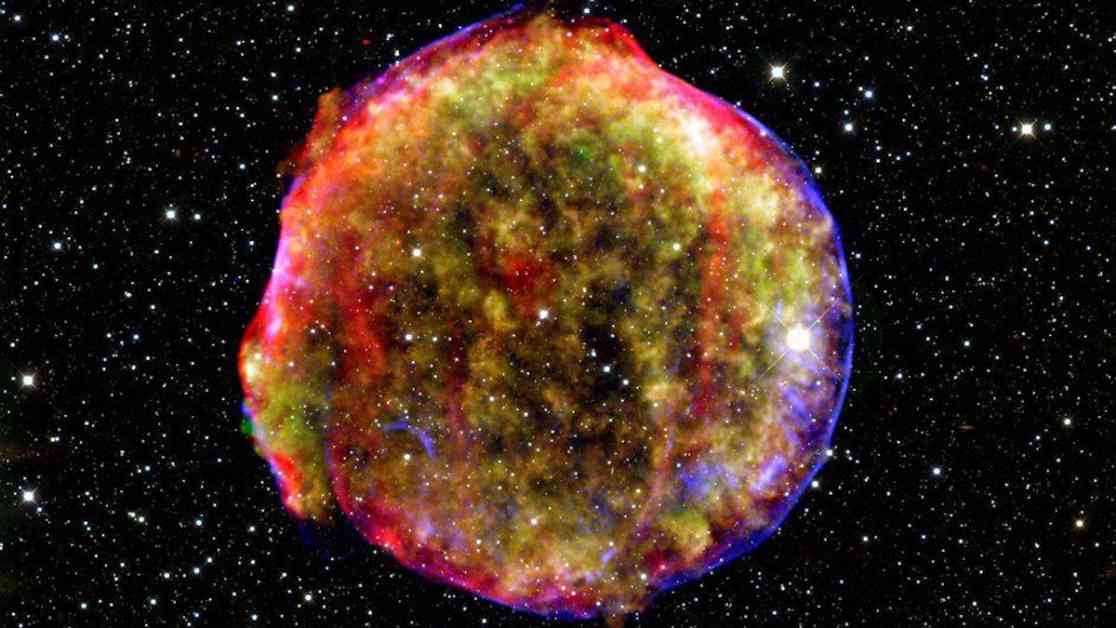Tycho, one of the best studied supernova remnants, may have briefly served as the most powerful collider in the universe, new research hints. Supernovas can become some of the most powerful particle colliders in the universe — but only if they pass a whole lot of gas before they explode, new research finds. For almost a century, astronomers have detected high-energy particles streaming in from the distant universe. Known as cosmic rays, they are made primarily of protons and, occasionally, nuclei of heavier elements. Most cosmic rays are deflected by Earth’s magnetic field or are absorbed in the upper atmosphere, but some make it all the way to the surface. Roughly once every second, a cosmic ray manages to strike your body. The cosmic rays span a broad range of energies, with the most powerful ones topping one peta-electron volt (PeV). That’s one quadrillion electron volts, or up to a thousand times more powerful than the collision energies of the Large Hadron Collider, the world’s most powerful atom smasher. Astronomers have long suspected that the explosive deaths of massive stars may be responsible for these extremely powerful cosmic rays. After all, these supernovas have all the right ingredients: There is a detonation with more than enough energy, a flood of elementary particles, and magnetic fields that can drive those particles into a frenzy before releasing them into the cosmos. But observations of nearby supernova remnants such as Tycho and Cassiopeia A have not met expectations; the cosmic rays coming from those places are far weaker than expected. In a paper accepted for publication in the journal Astronomy & Astrophysics, researchers have rescued the supernova hypothesis and found that, in special cases, supernova remnants are indeed capable of becoming “PeVatrons” — that is, explosions capable of generating PeV cosmic rays. The team found that, before going supernova, a star must lose a significant amount of mass — at least two suns’ worth of material. This is fairly common, as powerful winds can drive off the outer layers of a star’s atmosphere prior to the main explosion. But crucially, that material can’t disperse too widely. It has to stay dense, compact and close to the star. Then, when the supernova finally happens, the shock wave from the exploding star slams into this shell of material. And then all hell breaks loose. As the shock travels through the surrounding shell, magnetic fields ramp up to incredibly powerful energies. These magnetic fields take any random subatomic particles — the debris in the shell — and accelerate them, bouncing them back and forth within the shock wave. With every bounce, the particle gains more energy. Finally, it gets enough energy to leave the chaos altogether and stream into the universe. But within a few months, the system loses steam as the shock wave slows down. It still produces abundant cosmic rays, but not above the PeV threshold. This scenario explains why we haven’t directly observed any active PeVatrons. Even though a supernova goes off in the Milky Way every few years, none have been close enough in modern times for us to observe the short window when they can accelerate cosmic rays to these extreme energies. So we’ll just have to be patient. Paul M. Sutter is a research professor in astrophysics at SUNY Stony Brook University and the Flatiron Institute in New York City. He regularly appears on TV and podcasts, including “Ask a Spaceman.” He is the author of two books, “Your Place in the Universe” and “How to Die in Space,” and is a regular contributor to Space.com, Live Science, and more. Paul received his PhD in Physics from the University of Illinois at Urbana-Champaign in 2011, and spent three years at the Paris Institute of Astrophysics, followed by a research fellowship in Trieste, Italy.
Most Powerful Particle Collider in the Universe Unveiled
466










